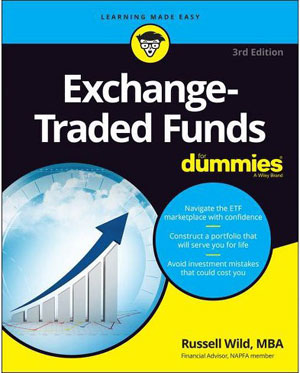BOOK REVIEW
| Print this Article |
ETFs for individual investors
By N. Russell Wayne

Get ready to be overwhelmed by the amount of information provided in Exchange-Traded Funds for Dummies, Third Edition, by NAPFA member Russell Wild.
This encyclopedic presentation runs the ever-broadening gamut of ETFs and is best suited for individual investors. The early sections provide a well-balanced context for these increasingly popular investment vehicles. The later sections introduce many different asset classes and representative ETFs.
I’ve spent more than five decades pondering the world of investments and greatly appreciate the depth of detail presented here. With rare exceptions, if it’s not found in this book, it’s probably not worth knowing about.
Although the title focuses on ETFs, the discussion covers virtually all key asset classes, ranging from equities to fixed income to alternatives and from the U.S. to markets around the world. Plan to spend a long time reading and absorbing the thoughts on these pages. Whether you really need to read it cover to cover is another story.
I commend the author for the thoroughness of his efforts. There are few stones unturned. For each of the asset classes noted, there are introductions to the distinctive characteristics of each and why they may be worth considering. And there are listings of notable (and sometimes not-so-notable) ETFs in each.
Wild doesn’t stop there, however. Indeed, he makes recommendations for the construction and periodic rearrangement of these pieces. Much time will be needed to digest the material presented and develop a simplified system of putting these ideas into action.
No Holy Grail here
With that said, I’m always troubled by attempts to teach investors what to do. Every author seems to have their own take on how to invest, and this book is no exception. Investors who buy these kinds of books are usually seeking the Holy Grail, i.e., the magic formula for investing, but like other books of this genre, the ideas presented are just that, ideas, not golden rules. Read the book for the information on its pages, not for the author’s suggestions on how to invest.
Growth versus value: Surprise is the key
A few nitpicks.
The lengthy discussion about growth versus value misses the key reason for the different returns over time. Holdings labeled growth are more highly valued and as such are more likely to suffer substantial losses when their results disappoint. Value holdings, on the other hand, are leanly valued and typically rise disproportionately when results are much better than expected. Over time, although gains from most growth stocks will probably exceed those of the value stocks, the plunges that take place on the growth side in the wake of disappointment tend to bring the average returns from growth stocks as a group below those of value stocks as a group. The difference is one word: surprise.
A while back, I did a 20-year study of the impact of surprise on the S&P 500 universe. For that study, the universe was divided into deciles, both in terms of price-earnings ratio and dividend yield, the two key characteristics for the growth and value labels. The deciles were measured from high to low. In perfect order, the deciles with the highest dividend yields delivered the highest returns. The deciles with the lowest price-earnings ratios had the same result, except for one decile that was not in perfect order. These results were primarily due to surprise. Recognition of the surprise factor is essential to the concepts presented, but did not get proper acknowledgment in this book.
The discussion of price-earnings ratios should have included the next step: price-to-growth (PEG) ratios. Price-earnings ratios by themselves have little value in the absence of comparison to the company’s ongoing rate of growth. The higher the growth rate, the higher the justifiable price-earnings ratio. As a rule of thumb, reasonable PEG ratios tend to be lower than 2.0. This critical metric is essential.
Price-earnings ratios reflect both prospective growth rates as well as investors’ confidence in companies’ abilities to continue that growth. That confidence comes from consistency of past growth, not the rate of past growth. Thus, companies with consistently high growth will get high valuations. The flip side is companies exposed to boom-and-bust cycles. These cyclical companies get low valuations.
Wild discusses using many different ingredients in portfolio construction. That may appear to be a superior approach, but simpler is often best and far less difficult to track. A few broad holdings will often get the job done adequately with far less effort. This comes under the heading “Keep It Simple, Stupid.”
I wonder about a couple of the examples in the book, too. On page 37, Wild mentions Jeff Vinik. In the 1980s, Jeff was one of our trainees at Value Line, where I was managing editor of The Value Line Investment Survey. He later managed Fidelity’s vaunted (at the time) Magellan Fund, which had done brilliantly under the stewardship of Peter Lynch. Jeff, however, made a huge blunder by moving 30% of the fund’s assets into bonds, and the fund’s returns suffered markedly. That action was followed by his departure from the firm. The reallocation was not part of Value Line’s trainee curriculum.
The reference to Bill Miller should have included the fund’s disaster of 2008, which led to a two-thirds loss of value. Even after 15 years of beating the market, Miller, too, lost his “touch.”
Exchange-Traded Funds for Dummies, Third Edition, is published by John Wiley & Sons at a list price of $29.99. It is also available as an e-book.
N. Russell Wayne, CFP®, is a member of NAPFA. Mr. Wayne, president of Sound Asset Management, has appeared on CNN and the Bloomberg Network and been quoted in The Wall Street Journal, The New York Times, Barron’s, and Business Week.

